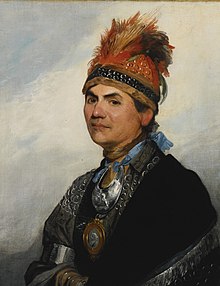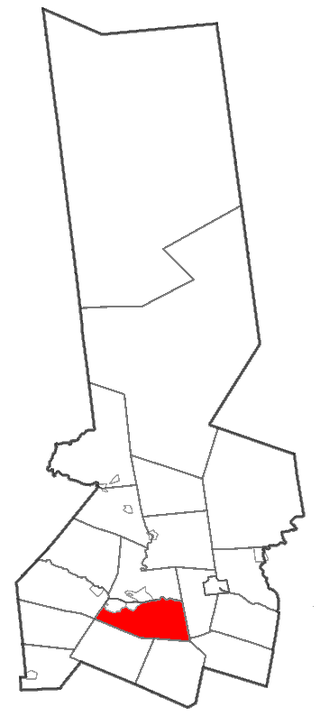
German Flatts is a town in Herkimer County, New York, United States. The population was 13,258 at the 2010 census.

Thayendanegea or Joseph Brant was a Mohawk military and political leader, based in present-day New York, who was closely associated with Great Britain during and after the American Revolution. Perhaps the best known Native American of his generation, he met many of the most significant American and British people of the age, including both George Washington and King George III.
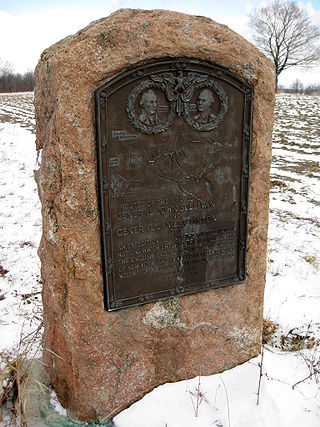
The 1779 Sullivan Expedition was a United States military campaign during the American Revolutionary War, lasting from June to October 1779, against the four British allied nations of the Iroquois. The campaign was ordered by George Washington in response to the 1778 Iroquois and British attacks on Wyoming, German Flatts, and Cherry Valley. The campaign had the aim of "taking the war home to the enemy to break their morale". The Continental Army carried out a scorched-earth campaign in the territory of the Iroquois Confederacy in what is now western and central New York.

The Battle of Oriskany was a significant engagement of the Saratoga campaign of the American Revolutionary War, and one of the bloodiest battles in the conflict between Patriot forces and those loyal to Great Britain. On August 6, 1777, several hundred of Britain's Indigenous allies, accompanied by Loyalists of the King's Royal Regiment of New York and the British Indian Department, ambushed a Patriot militia column which was marching to relieve the siege of Fort Stanwix. This was one of the few battles in which the majority of the participants were American colonists. Patriots and allied Oneidas fought against Loyalists and allied Iroquois and Mississaugas. No British regulars were involved; however, a detachment of Hessians was present.

Brigadier General Nicholas Herkimer was an American Palatine military officer who fought during the Revolutionary War. He died of wounds after the Battle of Oriskany.
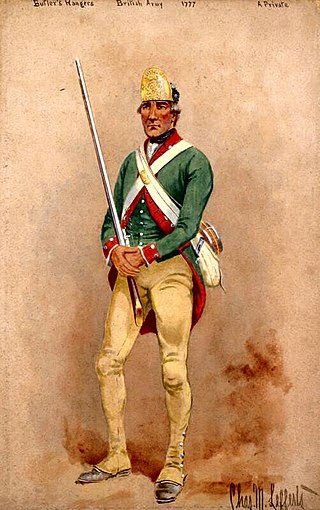
Butler's Rangers (1777–1784) was a Loyalist provincial military unit of the American Revolutionary War, raised by American loyalist John Butler. Most members of the regiment were Loyalists from upstate New York and northeastern Pennsylvania. Their winter quarters were constructed on the west bank of the Niagara River, in what is now Niagara-on-the-Lake, Ontario. The Rangers fought principally in New York and Pennsylvania, but ranged as far west as Ohio and Michigan, and as far south as Virginia and Kentucky.

The Cherry Valley massacre was an attack by British and Iroquois forces on a fort and the town of Cherry Valley in central New York on November 11, 1778, during the American Revolutionary War. It has been described as one of the most horrific frontier massacres of the war. A mixed force of Loyalists, British soldiers, Senecas, and Mohawks descended on Cherry Valley, whose defenders, despite warnings, were unprepared for the attack. During the raid, the Seneca in particular targeted non-combatants, and reports state that 30 such individuals were killed, in addition to a number of armed defenders.
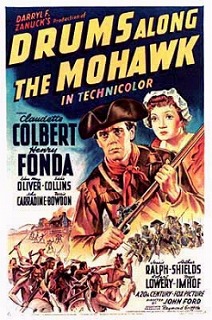
Drums Along the Mohawk is a 1939 American historical drama western film based upon a 1936 novel of the same name by American author Walter D. Edmonds. The film was produced by Darryl F. Zanuck and directed by John Ford. Henry Fonda and Claudette Colbert portray settlers on the New York frontier during the American Revolution. The couple experiences British, Tory, and Native American attacks on their farm before the Revolution ends and peace is restored.

The Battle of Wyoming, also known as the Wyoming Massacre, was a military engagement during the American Revolutionary War between Patriot militia and a force of Loyalist soldiers and Iroquois warriors. The battle took place in the Wyoming Valley of Pennsylvania on July 3, 1778 in what is now Luzerne County. The result was an overwhelming defeat for the Americans. There were roughly 300 Patriot casualties, many of whom were killed by the Iroquois as they fled the battlefield or after they had been taken prisoner.

Adam Frederick Helmer, also known as John Adam Frederick Helmer and Hans Adam Friedrich Helmer, was an American Revolutionary War hero among those of the Mohawk Valley and surrounding regions of New York State. He was made nationally famous by Walter D. Edmonds' popular 1936 novel Drums Along the Mohawk with its depiction of "Adam Helmer's Run" of September 16, 1778, to warn the people of German Flatts of the approach of Joseph Brant and his company of Indians and Tories.
Onaquaga was a large Iroquois village, located on both sides of the Susquehanna River near present-day Windsor, New York. During the American Revolutionary War, the Continental Army destroyed it and nearby Unadilla in October 1778 in retaliation for British and Iroquois attacks on frontier communities.

Molly Brant, also known as Mary Brant, Konwatsi'tsiaienni, and Degonwadonti, was a Mohawk leader in British New York and Upper Canada in the era of the American Revolution. Living in the Province of New York, she was the consort of Sir William Johnson, the British Superintendent of Indian Affairs, with whom she had eight children. Joseph Brant, who became a Mohawk leader and war chief, was her younger brother.
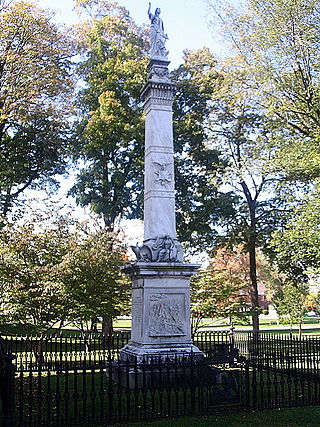
The Battle of Minisink was a battle of the American Revolutionary War fought at Minisink Ford, New York, on July 22, 1779. It was the only major skirmish of the Revolutionary War fought in the upper Delaware valley. The battle was a decisive British victory, as the Patriot militia was hastily assembled, ill-equipped and inexperienced.
Johannes Justus Schuyler was a Tory with patriot roots, who was used by American General Benedict Arnold to repel the British and Indian forces of Colonel Barry St. Leger and Joseph Brant from their siege of Fort Stanwix following the Battle of Oriskany during the American Revolution.

The Battle of Cobleskill was an American Revolutionary War raid on the frontier settlement of Cobleskill, New York on May 30, 1778. The battle, having taken place in the modern-day hamlet of Warnerville, New York, near the modern (2019) Cobleskill-Richmondville High School, marked the beginning of a phase in which Loyalists and Iroquois, encouraged and supplied by British authorities in the Province of Quebec, raided and destroyed numerous villages on what was then the United States western frontier of New York and Pennsylvania.
William Caldwell was an Irish-born military officer and colonial official in the British Indian Department. He fought against the Patriots in the American Revolutionary War, especially with Butler's Rangers, based near upstate New York. After the war, together with other Loyalists, Caldwell was granted land in Upper Canada. He helped found the town of Amherstburg, near the mouth of the Detroit River. He also served as a lieutenant colonel in the War of 1812, and as the Superintendent of Indians in the Western Department. He was a merchant and farmer in Amherstburg.

The northern theater of the American Revolutionary War after Saratoga consisted of a series of battles between American revolutionaries and British forces, from 1778 to 1782 during the American Revolutionary War. It is characterized by two primary areas of activity. The first set of activities was based around the British base of operations in New York City, where each side made probes and counterprobes against the other's positions that sometimes resulted in notable actions. The second was essentially a frontier war in Upstate New York and rural northern Pennsylvania that was largely fought by state militia companies and some Indian allies on the American side, and Loyalist companies supported by Indians, British Indian agents, and occasionally British regulars. The notable exception to significant Continental Army participation on the frontier was the 1779 Sullivan Expedition, in which General John Sullivan led an army expedition that drove the Iroquois out of New York. The warfare amongst the splinters of the Iroquois Six Nations were particularly brutal, turning much of the Indian population into refugees.
The Battle of Klock's Field was an engagement during the American Revolutionary War in the Mohawk Valley region of New York between British, Loyalist and Iroquois forces led by Lieutenant Colonel Sir John Johnson, and New York Levies and militia led by Brigadier General Robert Van Rensselaer. The battle occurred on the north side of the Mohawk River in what is now St. Johnsville in Montgomery County. The result was inconclusive with neither side able to claim a clear victory.

Brant's Volunteers, also known as Joseph Brant's Volunteers, were an irregular unit of Loyalist and indigenous volunteers raised during the American Revolutionary War by Mohawk war leader, Joseph Brant, who fought on the side of the British on the frontier of New York. Being military associators, they were not provided soldiers' uniforms, weapons, or pay by the British government, and survived by foraging and plundering.

The Raid on Unadilla and Onaquaga was a series of military operations by Continental Army forces and New York militia against the Iroquois towns of Unadilla and Onaquaga in what is now upstate New York. In early October 1778, more than 250 men under the command of Lieutenant Colonel William Butler of the 4th Pennsylvania Regiment descended on the two towns and destroyed them, razing most of the buildings and taking or destroying provisions, including the people's winter stores.


